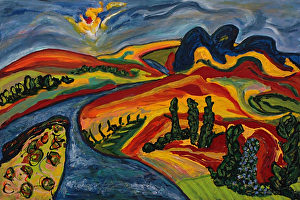 Nourishing the Desert
Nourishing the Desert
acrylic painting/ 36” by 24”/ $499
A diversity of people composes the fabric of our society. As we look at it from afar we see that the whole creates a beautiful landscape that is more dramatic than the parts. Once the land is nourished the garden can burst into bloom.
The following excerpt is from Lives of Museum Junkies available month end on Amazon. Keep posted for more information. As a museum professional, I was privy to many experiences that influenced how I think about our country’s racial divide. After Martin Luther King’s march, I assumed we had overcome a hurdle and we would live in a more compassionate place. Unfortunately, when I listen to the news today, I realize that lack of understanding between various racial groups continues. Yet, I am reminded of my youth and how a biased childhood made it difficult to understand the implications of a diverse society. I had to change before I could nourish others. The following excerpt is one of many events that made me do so.
Nourishing Diversity
“I got to know of Earvin Johnson’s mother, the school’s cleaning lady, during a time when Earvin became a local hero. She and her husband were supportive of their talented son and encouraged him to better his basketball chances at all white Everette High. The transition was difficult. He encountered a great many racial incidents, as he wrote in his autobiography Life, but eventually realized that they helped him “understand white people, how to communicate and deal with them.”
Earvin was anointed the moniker “Magic” at the age of fifteen when a writer for the local paper recorded a triple-double of 36 points, 18 rebounds and 16 assists. Earvin had so many fans that the high school had to use Michigan State University’s field house for his games. Not giving into pressure to go elsewhere, upon graduation he enrolled locally and we all got to celebrate when MSU’s basketball team won the college championship.
A few years later, while Magic was playing for the Los Angeles Laker I was invited to attend a birthday party his father organized in Lansing. Having lived most of my life in a white environment, the party was a culturally electric experience. I was one of the 10% of attendees who were white and the event made me realize how little I knew about the black community.
Guests were asked to dress in black or white, and once in the ballroom, the fashion show we beheld was spectacular. Johnson’s young female friends were especially dazzling, looking as though they had stepped off of a New York runway while the men, demonstrating their individuality, wore colored spats and bright suspenders under traditional black tuxedos.
At 7 p.m. the doors were locked to late arrivals. I sat down next to a state senator at an all white table when seven L.A. Laker giants, accompanied by tall, stunning females, entered amid flashing lights, and excited shouting fans. Projecting his well-recognized smile, Magic was in his element when speaking, leaving guests to realize that there was much more ambition in him than simply a basketball player. His favorite band had been flown in from L.A. as a birthday gift from his father. While it played, the black crowd moved and applauded to the sounds while those of us who were white sat stoically in our seats wondering, not understanding.
This party was my first total immersion into a culturally unfamiliar environment. Just as Earvin had to learn about white America, I needed to be exposed to and learn about black culture. I observed many interactions during that evening that made me feel uncomfortable, and I began to wonder how difficult it might be for a minority child to visit a museum where most attendees were white. My eyes were just starting to open.”
________________________
Many experiences over many years helped me become invested in seeing that all elements of society receive an education and life a rewarding life. Lives of Museum Junkies explores what I and others have done to ensure that the underrepresented population is served. My present work with street youth is an extension of the sensibilities I gained while working in museums.
______________________________
Art work is always for sale. Contact me at marilynne@eichingerfineart.com
Do respond with your thoughts by clicking BLOG.
___________________________
 For sale on Amazon by Marilynne Eichinger: The True Story of Streetwise, overcoming homelessness and beating the odds. Go to AMAZON .
For sale on Amazon by Marilynne Eichinger: The True Story of Streetwise, overcoming homelessness and beating the odds. Go to AMAZON .
Home » Blog » Nourishing Dieversity
Table of Contents
acrylic painting/ 36” by 24”/ $499
A diversity of people composes the fabric of our society. As we look at it from afar we see that the whole creates a beautiful landscape that is more dramatic than the parts. Once the land is nourished the garden can burst into bloom.
The following excerpt is from Lives of Museum Junkies available month end on Amazon. Keep posted for more information. As a museum professional, I was privy to many experiences that influenced how I think about our country’s racial divide. After Martin Luther King’s march, I assumed we had overcome a hurdle and we would live in a more compassionate place. Unfortunately, when I listen to the news today, I realize that lack of understanding between various racial groups continues. Yet, I am reminded of my youth and how a biased childhood made it difficult to understand the implications of a diverse society. I had to change before I could nourish others. The following excerpt is one of many events that made me do so.
Nourishing Diversity
“I got to know of Earvin Johnson’s mother, the school’s cleaning lady, during a time when Earvin became a local hero. She and her husband were supportive of their talented son and encouraged him to better his basketball chances at all white Everette High. The transition was difficult. He encountered a great many racial incidents, as he wrote in his autobiography Life, but eventually realized that they helped him “understand white people, how to communicate and deal with them.”
Earvin was anointed the moniker “Magic” at the age of fifteen when a writer for the local paper recorded a triple-double of 36 points, 18 rebounds and 16 assists. Earvin had so many fans that the high school had to use Michigan State University’s field house for his games. Not giving into pressure to go elsewhere, upon graduation he enrolled locally and we all got to celebrate when MSU’s basketball team won the college championship.
A few years later, while Magic was playing for the Los Angeles Laker I was invited to attend a birthday party his father organized in Lansing. Having lived most of my life in a white environment, the party was a culturally electric experience. I was one of the 10% of attendees who were white and the event made me realize how little I knew about the black community.
Guests were asked to dress in black or white, and once in the ballroom, the fashion show we beheld was spectacular. Johnson’s young female friends were especially dazzling, looking as though they had stepped off of a New York runway while the men, demonstrating their individuality, wore colored spats and bright suspenders under traditional black tuxedos.
At 7 p.m. the doors were locked to late arrivals. I sat down next to a state senator at an all white table when seven L.A. Laker giants, accompanied by tall, stunning females, entered amid flashing lights, and excited shouting fans. Projecting his well-recognized smile, Magic was in his element when speaking, leaving guests to realize that there was much more ambition in him than simply a basketball player. His favorite band had been flown in from L.A. as a birthday gift from his father. While it played, the black crowd moved and applauded to the sounds while those of us who were white sat stoically in our seats wondering, not understanding.
This party was my first total immersion into a culturally unfamiliar environment. Just as Earvin had to learn about white America, I needed to be exposed to and learn about black culture. I observed many interactions during that evening that made me feel uncomfortable, and I began to wonder how difficult it might be for a minority child to visit a museum where most attendees were white. My eyes were just starting to open.”
________________________
Many experiences over many years helped me become invested in seeing that all elements of society receive an education and life a rewarding life. Lives of Museum Junkies explores what I and others have done to ensure that the underrepresented population is served. My present work with street youth is an extension of the sensibilities I gained while working in museums.
______________________________
Art work is always for sale. Contact me at marilynne@eichingerfineart.com
Do respond with your thoughts by clicking BLOG.
 For sale on Amazon by Marilynne Eichinger: The True Story of Streetwise, overcoming homelessness and beating the odds. Go to AMAZON .
For sale on Amazon by Marilynne Eichinger: The True Story of Streetwise, overcoming homelessness and beating the odds. Go to AMAZON .
___________________________
Table of Contents